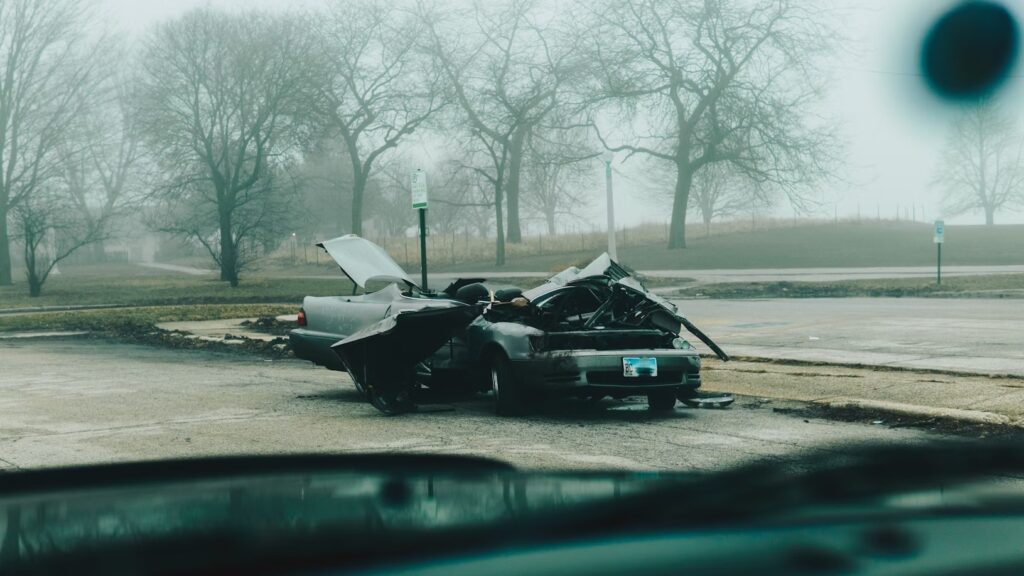A surge in traffic incidents across Colorado Springs merits investigation into contributing factors beyond the realm of driver behavior. While distracted and impaired driving remain significant concerns, the unique topographical and infrastructural elements of the region present distinct challenges for motorists.
This blog post delves into three prevalent accident triggers within the Colorado Springs area: blind spots, merging zones, and roundabouts. The aim is to comprehensively analyze these elements and outline preventative strategies.
Blind Spots
The picturesque yet challenging landscape of Colorado Springs presents a unique obstacle for drivers: pervasive blind spots. The city’s topography, characterized by winding roads and significant elevation changes, creates obstructed sight lines. Imagine navigating a narrow, hilly street lined with towering buildings or walls. These structures effectively conceal crucial sections of the road, hindering a driver’s ability to assess their surroundings.
This inherent danger is further amplified by the prevalence of large vehicles, like SUVs and trucks, on these roadways. These behemoths create expansive blind spots, obscuring smaller cars, cyclists, and pedestrians from view. Notorious examples include the northbound I-25 to westbound US-24 interchange and the transition from northbound Nevada Avenue to eastbound Fillmore Street.
According to Fox21 News, on March 11, a serious collision occurred at the intersection of Nevada Avenue and Winters Drive, near UCCS. It resulted in one person being hospitalized with severe injuries.
This incident, involving a car and a motorcycle, highlights the potential dangers of this area, particularly for motorcyclists. The location’s proximity to the busy Austin Bluffs Parkway underscores the need for heightened awareness and caution when navigating this stretch of road.
The sharp turn from southbound Cascade Avenue onto westbound Cimarron Street poses a similar challenge.
To navigate Colorado Springs’ blind spots effectively, a proactive approach is paramount. Motorists must cultivate a heightened sense of awareness. This includes checking their side and rearview mirrors while also performing a comprehensive visual check—a head turn. This can go a long way in eliminating any potential blind spots before initiating lane changes or merges.
Maintaining a safe following distance and exercising patience during lane changes are additional crucial safety measures.
Merging Maelstrom
The intricate web of highways crisscrossing Colorado Springs presents a formidable challenge to both seasoned locals and unsuspecting visitors. The city’s unique topography is characterized by sudden elevation changes and winding mountain roads. This exacerbates the complexity of merging maneuvers.
The infamous “I-25 Gap” project, stretching 18 miles between Monument and Castle Rock, has introduced additional merging complexities.
A tragic incident on I-25 near Mead, in August 2022, underscores the dangers of oversized loads on Colorado highways. According to CBS News, a semi-truck carrying an excavator collided with an overpass, resulting in a fatal crash involving a Honda SUV. The 32-year-old female driver lost her life, while a child passenger sustained serious injuries.
Behavioral factors also play a significant role. Aggressive merging behaviors increase during peak commute hours. This includes last-minute lane changes and failure to yield, often triggered by time pressures and frustration.
The Colorado Department of Transportation recommends the “zipper merge” technique, to mitigate the risks. In this method, drivers use both lanes until the merge point and alternate. This reduces congestion and accidents when properly executed.
Advanced driver assistance systems (ADAS) are becoming invaluable allies in navigating the merging challenges. Features like blind-spot monitoring and adaptive cruise control can provide crucial support, particularly on busy stretches like the Powers Boulevard corridor.
You must remain vigilant, employing defensive driving techniques when on the road. These include maintaining proper following distances and anticipating merge points well in advance.
In Colorado Springs’ challenging merging conditions and the potential for serious accidents, it’s crucial to understand your legal rights and options. The complexity of these incidents often involves multiple vehicles and factors like road design or oversized loads. This can make determining liability difficult.
Springs Law Group states that dealing with medical bills and uncooperative insurance companies can be daunting for an average person. After all, insurance companies have a reputation for being frugal when paying out compensation to victims of auto accidents. But, you do not have to traverse this path alone.
If you’ve been involved in a merger-related accident, consulting with an experienced Colorado Springs auto accident attorney is essential. These legal professionals specialize in navigating the intricacies of local traffic laws. Moreover, they can help you secure appropriate compensation for medical expenses, lost wages, and pain and suffering.
Roundabouts
Colorado Springs’ embrace of roundabouts has introduced a unique set of navigational challenges for drivers. The city’s topography and urban design have transformed these traffic circles into potential hazard zones, demanding heightened awareness and skill.
Take the North Academy Boulevard and Voyager Parkway intersection. Its tight curve tests even seasoned drivers’ abilities to gauge traffic flow and timing. Or, consider the multi-lane labyrinth at Briargate Parkway and Lexington Drive. Here, a nearby shopping center entrance adds an extra layer of complexity to an already intricate traffic pattern.
These roundabouts aren’t just inconveniences; they’re statistical hotspots for accidents.
Mastering these circular intersections requires more than just following the “yield to the left” rule. It demands a nuanced understanding of each roundabout’s specific layout, as designs vary significantly across the city.
Drivers must approach with caution, reduce speed, and remain vigilant when exiting. This is the moment when many accidents occur due to sudden lane changes or a failure to signal.
Important Safety Tactics
Colorado Springs’ complex driving environment demands heightened awareness and specialized skills. This analysis delves into the city’s unique challenges and provides tailored strategies for safe navigation.
Topographical Challenges
Colorado Springs’ elevation fluctuations present significant vehicular stress. On steep descents like those on Gold Camp Road, engage lower gears to maintain speeds below 20 mph. It is advisable to utilize engine braking to prevent brake fade.
When ascending, use the CDOT-approved pullout areas every 2-3 miles to allow faster traffic to pass safely, reducing congestion and potential rear-end collisions.
Meteorological Considerations
The city’s microclimates, particularly those influenced by the Palmer Divide, necessitate adaptive driving techniques. Equip your vehicle with all-weather tires featuring the Three-Peak Mountain Snowflake (3PMSF) symbol. These have been found to outperform standard M+S (mud and snow) tires in temperatures below 45 °F.
Monitor real-time road conditions via CDOT’s COtrip.org. Try to pay special attention to high-risk areas like the I-25 gap between Monument and Castle Rock, where the weather can change rapidly.
Infrastructure Navigation
Colorado Springs’ expanding road network includes complex interchanges that require precise navigation. When approaching the diverging diamond interchange at I-25 and Fillmore Street, adhere strictly to lane markings and signage. Reduce speed to 35 mph in the interchange and avoid lane changes within the crossover points to prevent sideswipe collisions.
Traffic Flow Management
On high-volume arterials like Powers Boulevard, implement the zipper merge technique when encountering lane closures. Begin merging at the designated merge point, alternating one vehicle from each lane, to reduce traffic backups. When merging, try to match highway speeds in the acceleration lanes. Moreover, aim for a 3-second gap between vehicles to ensure safe integration into traffic flow.
By incorporating these location-specific strategies, you can effectively navigate Colorado Springs’ unique road environment.
FAQs
Q1: How can I safely navigate Colorado Springs’ roundabouts?
A: Approach roundabouts with caution, reduce speed, and yield to traffic already in the circle. Be aware of each roundabout’s specific layout, as designs vary across the city. Signal your intentions clearly, especially when exiting, to avoid sudden lane changes and potential collisions.
Q2: What should I do if involved in a merging-related accident in Colorado Springs?
A: First, ensure everyone’s safety and call emergency services if needed. Document the accident scene and gather witness information. Then, consult an experienced Colorado Springs auto accident attorney to navigate local traffic laws and secure appropriate compensation for damages and injuries.
Q3: How can I prepare my vehicle for Colorado Springs’ varied weather conditions?
A: Equip your vehicle with all-weather tires featuring the Three-Peak Mountain Snowflake (3PMSF) symbol for better performance in cold temperatures. Regularly check and maintain your vehicle’s systems, especially the brakes and tires. Monitor real-time road conditions via CDOT’s COtrip.org before traveling.
To sum up, from winding mountain passes to modern traffic designs, the city presents a complex mix of navigational challenges. As the city grows, these challenges evolve, requiring you to adapt your skills.
The approach to road safety, outlined in the above sections, protects individual drivers and contributes to a safer transportation system for the entire community. Ultimately, safe navigation in Colorado Springs demands a combination of local knowledge, advanced driving techniques, and ongoing education.



